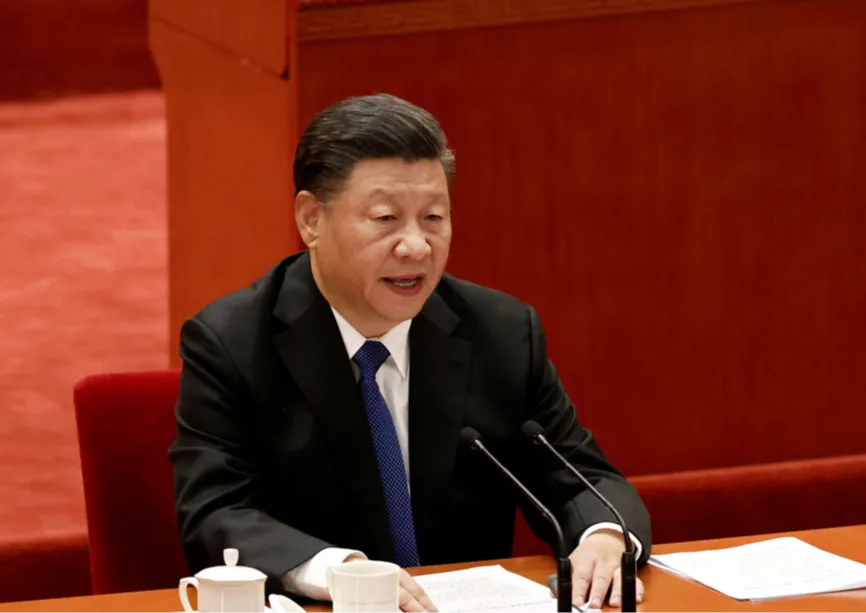-
CENTRES
Progammes & Centres
Location

In August 2000, Xi Jinping, on taking over as Governor of Fujian Province, gave a rare interview to the Chinese magazine Zhonghua Ernü, emphasising that “a new leader needed to set his own agenda in the first year” and “like a relay race, take the baton from the past leaders and run it past properly”. Twelve years later, in his address as President in 2012, he re-emphasised the baton analogy again to achieve “great rejuvenation of the Chinese nation”. As in 2000, he set out his own agenda to run the race differently from his predecessors, with a distinctive strategy and at an accelerated pace. Xi’s articulation of the new path removed the four decades of the Chinese facade of peaceful development.
Within a year of Xi in office, China News Service, the second largest state-run media outlet, published an article titled, ‘Six Wars China Must Fight in Next 50 Years’, chronicled as follows: (a) The War to unify Taiwan (2020-2025); (b) Recover the islands of South China Sea (2025-2030); (c) Reconquest of Southern Tibet (2035-2040); (d) Reconquest of Diaoyutai and Ryukyu Islands (2040-45); (e) Re-unification of Outer Mongolia; and (f) War to recover territory seized by the Russia (2055-2060). This was one of the clearest articulations of the Chinese strategic objectives along with precise timelines, with re-integration of Taiwan being the highest dream.
Historically, China espouses peaceful unification of Taiwan, mainly due to three critical considerations: (a) the United States (US)’ commitment of military support to Taiwan against Chinese aggression through the Taiwan Relations Act 1979; (b) Complexity of cross-strait amphibious operations; (c) If failed, it may lead to permanent loss of the unification dream and denting the Chinese image internationally.
China has webbed a quadri-pronged strategy to achieve this aim: (a) Propagating superiority of the Chinese model of peaceful development over the western democratic model; (b) Charm offensive promoting autonomy under ‘one nation two systems’ to assuage the fears of the fiercely independent-minded Taiwanese. Creating economic dependency by encouraging cross strait trade and deepening exchange between Taiwan and the mainland (c) Hollowing out resistance by a mix of measures using the three warfare strategy, along with a disinformation campaign such as spreading scepticism towards US support and military muscles flexing across the strait to deter pro-independence elements. (d) Isolating Taiwan by dissuading other nations from having formal diplomatic relations using economic and military clout.
Taiwan’s better performance on most of the human development indexes, along with a flourishing democracy, puncture the propaganda of the communist model of development.
Realistic analysis highlights the limited effectiveness of the above strategies. Comparison of the IMF per capita income data (GDP, Dec 22) pegged China at US $12,259, while Taiwan is almost at three times that at US$33,775. Also, Taiwan’s better performance on most of the human development indexes, along with a flourishing democracy, puncture the propaganda of the communist model of development. The CCP’s mask of promoting autonomy under ‘one nation two systems” came crashing down in 2019, while its brutal handling of the anti-extradition bill protestors in Hong Kong, causing severe backlash in Taiwan, resulting in the resounding victory of the pro-independence Democratic Progressive Party (DPP) in January 2020.
A poll conducted by the Taiwanese Public Opinion Foundation in August 2021 highlighted that 73 percent of the Taiwanese support Independence/Status-quo with only 11.1 percent supporting unification. A majority of the people also preferred to be identified as Taiwanese. Despite the Chinese disinformation campaign, interference in election processes, and efforts to consolidate opposition voters, the unprecedented third term for the DPP in the January 2024 elections further highlighted the limited appeal of the People’s Republic of China’s (PRC) propaganda and its dwindling hope of peaceful re-unification. Taiwan’s ‘New Southbound policy’ and measures to de-couple its economy from PRC are further making the Chinese charm offensive lose its sheen. With the US commitment to Taiwan remaining intact and having been re-affirmed through the Taiwan Policy Act of 2022, the only partial success China can claim is diplomatically isolating Taiwan, with only 13 smaller countries recognising it.
The PRC’s forcible seizure of Taiwan will strike at very core of the idea that it is the defender of freedom and democracy across the world, dealing a devastating blow to the US’ global power.
For a rising PRC aspiring to become a dominant global power, it is untenable that an alleged part of its territory remains outside its control. For the US, the PRC’s forcible seizure of Taiwan will strike at very core of the idea that it is the defender of freedom and democracy across the world, dealing a devastating blow to the US’ global power. It could change the balance in the western Pacific, shatter the first island chain encirclement, and end American primacy in the Indo-Pacific; therefore, the Taiwan Strait is an existential problem for both the superpowers. Based on the lessons from the Ukraine War, Beijing would attempt to topple the leadership in Taipei in a swift military action to present a “fait accompli” to the world.
Alternatively, it could try to impose a blockade to force the island into concessions by choking and cutting it off physically, economically and even digitally or as a precursor to wider military action. Recent Chinese military belligerence has alarmed Taipei, forcing it to initiate multiple defensive measures such as increasing the conscription period to one year from the existing four months, development of asymmetric warfare capabilities, and enhanced military sales from the US. The Ukraine conflict seems to have already convinced Washington and Taipei that a Chinese invasion is a possible danger, and that a smaller military, if armed with the right weapons, can beat back a larger force. With dwindling hope of peaceful re-integration, Xi must be exasperated seeing the closing window of the military option due to the enhanced Taiwanese counter-measures.
By removing the two-term limit and not nominating a successor, Xi have already shown his willingness to bite the hard bullets and has solidified his authority at the expense of the PRC’s most prominent political reform of the last century: The regular and peaceful transfer of power designed by Deng, who recognised the dangers of one-man rule and the cult of personality, and instead espoused collective leadership. While Xi might not remain in office till the fulfilment of the 2049 goal of the great rejuvenation, he is highly likely to gamble for the other long-cherished dream of re-unification of Taiwan within his term itself, a legacy cementing his place amongst the greats like Mao and Deng. With the US already embroiled in multiple crises from Ukraine to the Middle East in Gaza, Red Sea and Iraq, coupled with the West’s lost appetite for joining another security crisis may also present an enticing opportunity to Xi for preponing his military adventure across the strait with a ‘Go Big, Go Early’ approach.
Forced integration will not only embolden China for similar actions against other neighbours in the East and South China Seas but also remove its two-front dilemma, freeing its entire military might for its next war on Arunachal Pradesh (touted as Southern Tibet) in collusion with Pakistan—an Indian nightmare.
However, any status quo change in Taiwan will have serious security and economic repercussions across the globe, much higher in magnitude than the Ukraine war. Forced integration will not only embolden China for similar actions against other neighbours in the East and South China Seas but also remove its two-front dilemma, freeing its entire military might for its next war on Arunachal Pradesh (touted as Southern Tibet) in collusion with Pakistan—an Indian nightmare. India should avoid the monumental blunders of the ’50s, when it didn’t fully realise the repercussions of a Chinese occupation of Tibet, leading to a swallowing of the historical buffer between the two nations and creating a perennial threat of ‘salami slicing’ by the dragon along India’s northern borders. In the eventuality of any coercive actions by Beijing towards Taipei, India must get actively involved in support of Taiwan along with the US-led alliance. The degree and type of support may vary as the situation unfolds, but remaining neutral will not be an option. This will not only act as an important hedge for a reciprocal active western support against any Chinese misadventure along the Himalayas but also redeem India’s lost prestige during the occupation of Tibet.
Vidur Sharma is a Visiting Fellow at the Observer Research Foundation.
The views expressed above belong to the author(s). ORF research and analyses now available on Telegram! Click here to access our curated content — blogs, longforms and interviews.

Col Vidur Ji Sharma is an Indian Army officer commissioned into Mahar Regiment in May 2000. The officer has had varied operational experience of serving ...
Read More +